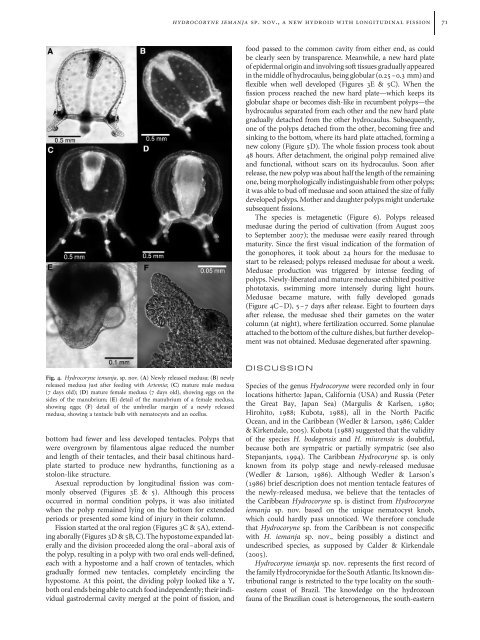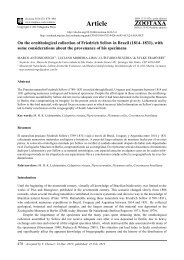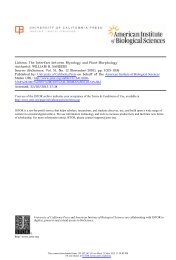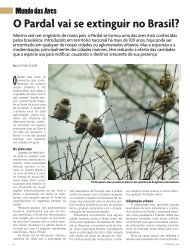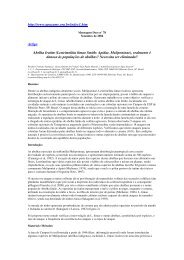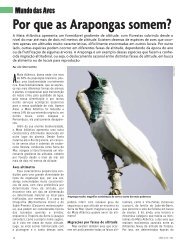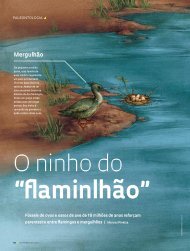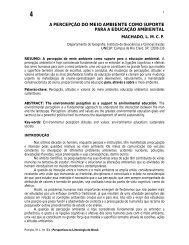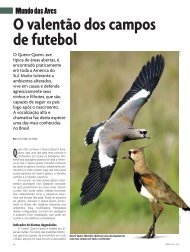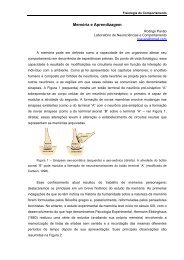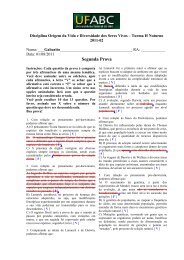Hydrocoryne iemanja (Cnidaria) - Instituto de Biociências - USP
Hydrocoryne iemanja (Cnidaria) - Instituto de Biociências - USP
Hydrocoryne iemanja (Cnidaria) - Instituto de Biociências - USP
You also want an ePaper? Increase the reach of your titles
YUMPU automatically turns print PDFs into web optimized ePapers that Google loves.
hydrocoryne <strong>iemanja</strong> sp. nov., a new hydroid with longitudinal fission 71<br />
food passed to the common cavity from either end, as could<br />
be clearly seen by transparence. Meanwhile, a new hard plate<br />
of epi<strong>de</strong>rmal origin and involving soft tissues gradually appeared<br />
in the middle of hydrocaulus, being globular (0.25–0.3 mm) and<br />
flexible when well <strong>de</strong>veloped (Figures 3E & 5C). When the<br />
fission process reached the new hard plate—which keeps its<br />
globular shape or becomes dish-like in recumbent polyps—the<br />
hydrocaulus separated from each other and the new hard plate<br />
gradually <strong>de</strong>tached from the other hydrocaulus. Subsequently,<br />
one of the polyps <strong>de</strong>tached from the other, becoming free and<br />
sinking to the bottom, where its hard plate attached, forming a<br />
new colony (Figure 5D). The whole fission process took about<br />
48 hours. After <strong>de</strong>tachment, the original polyp remained alive<br />
and functional, without scars on its hydrocaulus. Soon after<br />
release, the new polyp was about half the length of the remaining<br />
one, being morphologically indistinguishable from other polyps;<br />
it was able to bud off medusae and soon attained the size of fully<br />
<strong>de</strong>veloped polyps. Mother and daughter polyps might un<strong>de</strong>rtake<br />
subsequent fissions.<br />
The species is metagenetic (Figure 6). Polyps released<br />
medusae during the period of cultivation (from August 2005<br />
to September 2007); the medusae were easily reared through<br />
maturity. Since the first visual indication of the formation of<br />
the gonophores, it took about 24 hours for the medusae to<br />
start to be released; polyps released medusae for about a week.<br />
Medusae production was triggered by intense feeding of<br />
polyps. Newly-liberated and mature medusae exhibited positive<br />
phototaxis, swimming more intensely during light hours.<br />
Medusae became mature, with fully <strong>de</strong>veloped gonads<br />
(Figure 4C–D), 5–7 days after release. Eight to fourteen days<br />
after release, the medusae shed their gametes on the water<br />
column (at night), where fertilization occurred. Some planulae<br />
attached to the bottom of the culture dishes, but further <strong>de</strong>velopment<br />
was not obtained. Medusae <strong>de</strong>generated after spawning.<br />
Fig. 4. <strong>Hydrocoryne</strong> <strong>iemanja</strong>, sp. nov. (A) Newly released medusa; (B) newly<br />
released medusa just after feeding with Artemia; (C) mature male medusa<br />
(7 days old); (D) mature female medusa (7 days old), showing eggs on the<br />
si<strong>de</strong>s of the manubrium; (E) <strong>de</strong>tail of the manubrium of a female medusa,<br />
showing eggs; (F) <strong>de</strong>tail of the umbrellar margin of a newly released<br />
medusa, showing a tentacle bulb with nematocysts and an ocellus.<br />
bottom had fewer and less <strong>de</strong>veloped tentacles. Polyps that<br />
were overgrown by filamentous algae reduced the number<br />
and length of their tentacles, and their basal chitinous hardplate<br />
started to produce new hydranths, functioning as a<br />
stolon-like structure.<br />
Asexual reproduction by longitudinal fission was commonly<br />
observed (Figures 3E & 5). Although this process<br />
occurred in normal condition polyps, it was also initiated<br />
when the polyp remained lying on the bottom for exten<strong>de</strong>d<br />
periods or presented some kind of injury in their column.<br />
Fission started at the oral region (Figures 3C & 5A), extending<br />
aborally (Figures 3D & 5B, C). The hypostome expan<strong>de</strong>d laterally<br />
and the division procee<strong>de</strong>d along the oral–aboral axis of<br />
the polyp, resulting in a polyp with two oral ends well-<strong>de</strong>fined,<br />
each with a hypostome and a half crown of tentacles, which<br />
gradually formed new tentacles, completely encircling the<br />
hypostome. At this point, the dividing polyp looked like a Y,<br />
both oral ends being able to catch food in<strong>de</strong>pen<strong>de</strong>ntly; their individual<br />
gastro<strong>de</strong>rmal cavity merged at the point of fission, and<br />
DISCUSSION<br />
Species of the genus <strong>Hydrocoryne</strong> were recor<strong>de</strong>d only in four<br />
locations hitherto: Japan, California (USA) and Russia (Peter<br />
the Great Bay, Japan Sea) (Margulis & Karlsen, 1980;<br />
Hirohito, 1988; Kubota, 1988), all in the North Pacific<br />
Ocean, and in the Caribbean (Wedler & Larson, 1986; Cal<strong>de</strong>r<br />
& Kirkendale, 2005). Kubota (1988) suggested that the validity<br />
of the species H. bo<strong>de</strong>gensis and H. miurensis is doubtful,<br />
because both are sympatric or partially sympatric (see also<br />
Stepanjants, 1994). The Caribbean <strong>Hydrocoryne</strong> sp. is only<br />
known from its polyp stage and newly-released medusae<br />
(Wedler & Larson, 1986). Although Wedler & Larson’s<br />
(1986) brief <strong>de</strong>scription does not mention tentacle features of<br />
the newly-released medusa, we believe that the tentacles of<br />
the Caribbean <strong>Hydrocoryne</strong> sp. is distinct from <strong>Hydrocoryne</strong><br />
<strong>iemanja</strong> sp. nov. based on the unique nematocyst knob,<br />
which could hardly pass unnoticed. We therefore conclu<strong>de</strong><br />
that <strong>Hydrocoryne</strong> sp. from the Caribbean is not conspecific<br />
with H. <strong>iemanja</strong> sp. nov., being possibly a distinct and<br />
un<strong>de</strong>scribed species, as supposed by Cal<strong>de</strong>r & Kirkendale<br />
(2005).<br />
<strong>Hydrocoryne</strong> <strong>iemanja</strong> sp. nov. represents the first record of<br />
the family Hydrocorynidae for the South Atlantic. Its known distributional<br />
range is restricted to the type locality on the southeastern<br />
coast of Brazil. The knowledge on the hydrozoan<br />
fauna of the Brazilian coast is heterogeneous, the south-eastern


